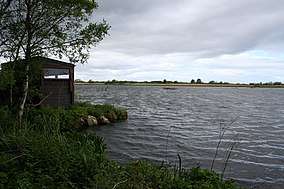Loch Spynie
Loch Spynie is a small loch located between the towns of Elgin and Lossiemouth in Moray, Scotland. Close to Spynie Palace, the ancient home of the bishops of Moray, it is an important wildlife habitat which is protected as a Ramsar Site.
| Loch Spynie | |
|---|---|
 Birdwatchers' hut on Loch Spynie | |
| Location | Moray, Scotland |
| Nearest city | Elgin |
| Coordinates | 57.681944°N 3.280556°W |
| Area | 0.94 km2 (0.36 sq mi)[1] |
| Established | 1992 |
| Governing body | Joint Nature Conservation Committee |
History
Loch Spynie is a remnant of a great wetland that stretched from the western shore of the current loch to the mouth of the River Lossie and, at that time, many of the settlements along the Moray coast were actually islands in the Moray Firth. The connections this area had to the sea silted up over the centuries but the Laich of Moray was still navigable in the middle ages. In the mid 19th century the Spynie canal was constructed by Thomas Telford to drain the Laich of Moray for farmland. Artificial shores were built on the western and northern sides of the loch which was kept for wildfowling and fishing.[2] Wildfowling has stopped altogether since 1981 and the amount of angling is been negligible since that year too.[3]
Natural history
Loch Spynie is a naturally eutrophic loch with extensive reedbeds surrounding the open water. It is one of the few Scottish localities for alder swamp woodland, and has an unusual aquatic community including the nationally scarce slenderleaf pondweed. Loch Spynie regularly supports internationally important numbers of roosting greylag geese, with up to 5% of the Iceland population over-wintering at the site.[4] Breeding birds here include grey heron, common tern, black-headed gull, water rail and little grebe, the gulls and terns nesting on artificial rafts. Osprey fish here in the Spring and Summer when marsh harriers may also be seen. In addition to the greylags, whooper swan, wigeon, teal, goldeneye and tufted duck arrive in the Autumn some wintering. Other wildlife includes red squirrel, otter, common frog and common toad.[5]
As well as being recognised as a wetland of international importance under the Ramsar Convention,[6] Loch Spynie has been designated a Special Protection Area and Site of Special Scientific Interest.[1] The RSPB has provided a bird hide and feeders which can be reached from the car park.[5]
References
- "Loch Spynie". Joint Nature Conservation Committee. Retrieved 2 May 2019.
- "Spynie Loch". Pitgaveny Farms Office. Retrieved 3 March 2020.
- "Commissioned Report No. 726 Investigation of Standing Water and Wetland SSSIs thought to be under Diffuse Pollution Pressure: Loch Spynie" (PDF). Scottish Natural Heritage. Retrieved 3 March 2020.
- "UK Loch Spynie 13043 RIS 2006" (PDF). Ramsar Sites Information Service. Retrieved 2 May 2019.
- "Loch Spynie". RSPB. Retrieved 3 March 2020.
- "Loch Spynie". Ramsar Sites Information Service. Retrieved 2 May 2019.